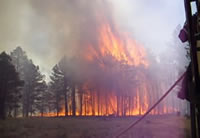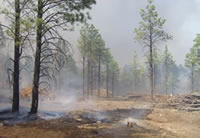
National Fire Plan Success Story
Effects of Vegetation Treatments on the Vincent Fire
Apache-Sitgreaves National Forest, Black Mesa Ranger District, Arizona
National Fire Plan - Fuels Reduction
The Vincent Fire started on the morning of May 29, 2007, outside of the treatment units contained in White Mountain Stewardship Projects Dutch Joe A and Dutch Joe B. These projects were designed to reduce the threat of wildfire to adjacent private lands. Aggressive thinning and slash removal had been completed in 2006 under the Dutch Joe A project; similar actions were in progress under the Dutch Joe B project.
In each project unit, the understory was thinned and trees up to 18 inches in diameter were removed. Remaining slash was chipped and transported to be burned at a 24 megawatt biomass plant. Large diameter trees were retained, but tree spacing was increased and ladder fuels were removed.
Once ignited, the Vincent Fire grew rapidly in size due to dense forest conditions, low humidity and moderate winds. The ground fire quickly moved into the canopy of untreated ponderosa pine stands, and tree torching and running crown fires were observed.

Vincent Fire in an untreated unit.

Vincent Fire in a treated unit.
However, once the fire hit the area treated by the Dutch Joe A and B projects, it dropped from the tree crowns to the ground. This fire behavior suggests that thinning and slash treatments are effective tools to moderate fire behavior from stand replacement events to ground fires that are far easier and safer to control.
Contact: David Maurer (928) 535-4481 or dmaurer@fs.fed.us